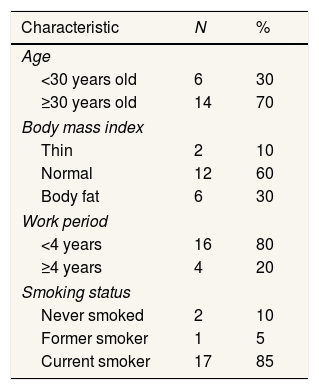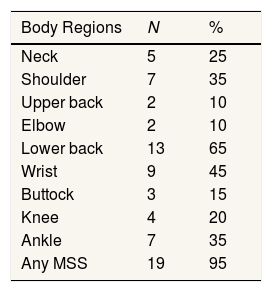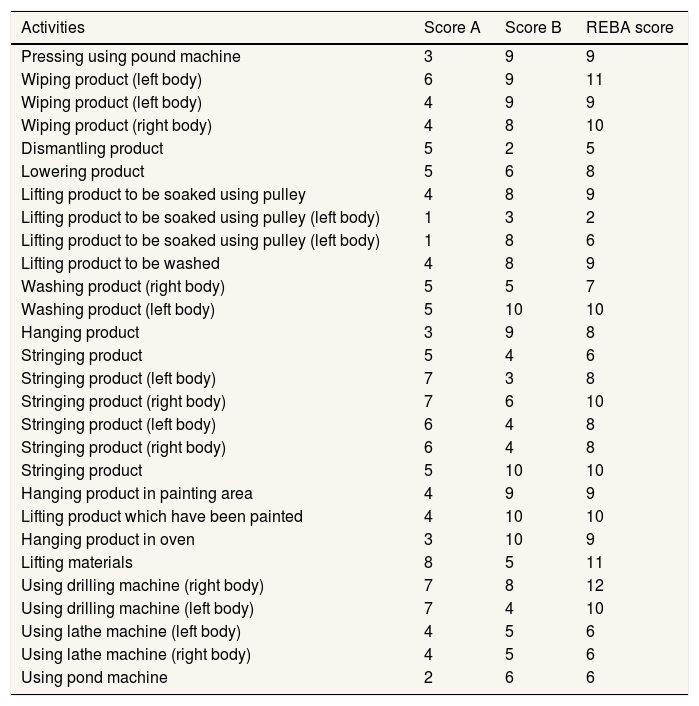
The 3rd International Nursing and Health Sciences Students and Health Care Professionals Conference (INHSP)
Más datosSmall and medium-sized enterprises (SMEs) play a major role in economic growth and employment, and they come with a greater risk of work-related illnesses for workers. Metal-based SMEs are recognised as the sector with the most demanding physical work activities and awkward postures, which are considered risk factors of musculoskeletal disorders (MSDs). This study analysed the risk factors of MSDs associated with different work postures during production.
MethodsBody postures were examined using the Rapid Entire Body Assessment (REBA) method, and the data on musculoskeletal symptoms were collected using the Nordic Musculoskeletal Questionnaire (NMQ).
ResultsThe results were calculated using the REBA method to determine the level of risk of various postures, namely, low risk (3.6%), medium risk (25.0%), high risk (60.7%), and very high risk (10.7%). The NMQ results indicated that most of the symptoms and discomfort were in the lower back (65%), wrist (45%), shoulder (35%), and ankle (35%) regions.
ConclusionsThe physical factors contributed more to the musculoskeletal symptoms in the body regions affected. The use of tools in lifting activities could decrease the level of risk.
Small and medium-enterprises (SMEs) play a major role in economic growth and employment,1 with workers at great risk of work-related ill health.2 Metal-based SMEs are recognised as the SMEs in which heavy physical work activities that cause musculoskeletal disorders (MSDs) are frequently performed.
In Europe, the total cost of lost productivity attributed to MSDs among people of working age was estimated to be as high as 2% of the gross domestic product.3
Lifting activities, repetitive movements, and awkward lifting postures may alleviate the risk of developing work-related MSDs.4 Moreover, workers who handle heavy loads with awkward postures (86.4%) had a higher percentage of developing MSDs than those who frequently manually handle heavy loads (45.5%).5
Individual risk factors for MSDs have been identified, such as age,6,7 gender,8 body mass index (BMI),9–11 smoking status,12,13 and lifting capacity (found to be the greatest in the 29–38-year-old age group).14,15
Previous studies showed that musculoskeletal symptoms (MSSs) in the lower back region prevailed among manual handling workers. Moreover, the prevalence of MSS has been reported as follows: 79% and 69.1% for the lower back, 70% and 50% for the neck, 64% for the knee, and 59% and 45% for the shoulder.16
With this background, this study analysed the risk factors of MSDs associated with different work postures during metal-based product fabrication.
MethodsThis work is a cross-sectional study that analysed working posture and MSDs at two metal-based SMEs at Bogor Regency, Indonesia. Body postures were examined using the Rapid Entire Body Assessment (REBA) method.17 Interviews were performed to obtain the respondents’ characteristics, such as age, work period, smoking status, and musculoskeletal symptoms (MSSs); as well as details of the way they perform their tasks (frequency and duration of the work). In total, 20 respondents were interviewed, who actively work in the workshops. The workers’ BMI index was obtained by measuring their height (in metre) and weighting their body mass (in kg).
REBA assessment was done by analysing photos that were taken while workers performed their job. A total of 28 postures were analysed to assess the neck, trunk, and leg postures (A score) and arm and wrist postures (B score). The final score of body posture (A+B score) further is compared with REBA criteria for risk level determination. Furthermore, Nordic Musculoskeletal Questionnaire18 was used to investigate the workers’ MSS experience in nine body regions: neck, shoulder, upper back, elbow, lower back, wrist, buttock, knee, and ankle.
ResultSME 1 has two workshops, one for producing stuff made of steel, such as trellis, flowerpot, and pet cage. In the time of the observation was conducted, workers in SME 1 was producing trellis, flowerpot made of metal, and producing metal seat using pound machine. Producing trellis and flowerpot involves tasks such as lifting, cutting and smoothing using grinder, bending, welding, and cleaning product.
There were three jobs that were observed in SME 2, i.e. producing pole trash can, producing bowls using a lathe machine, and moulding metal seat using pound machine. Pole trash can production involves tasks such as cutting, and smoothing using a grinder, welding, and hollowing out the metal using drilling.
Descriptive sampleThe descriptive sample is presented in Table 1. Most of the respondents were smokers (85%) with an average age of 36.8 years and an average BMI of 22.8kg/m2 (normal). The average work period of the workers was 0.8 years (9 months and 6 weeks).
Prevalence of MSSs for each body region in relation to the individual risk factorsThe prevalence of MSSs during the last 12 months is presented in Table 2. About 95% of the respondents reported MSSs in any of the nine body regions. MSSs were most frequent in the lower back (65%), wrists (45%), shoulders (35%) and ankles (35%). The lowest frequency of MSSs was in the upper back (10%) and elbows (10%).
MSSs in the four most frequent body regions were more prevalent among smokers, workers aged over 30 years, those with normal BMI, and those who had worked for less than 4 years. In addition, MSSs in the ankle region were reported to have the same prevalence for workers with a normal BMI and body fat percentage.
Level of physical risk factorsThe levels of physical risk factors are presented in Table 3. The REBA scores were determined by analysing the risks of various postures, which were rated from low to very high. The physical risk factors were predominantly high risk (60.7%), followed by medium risk (25.0%), very high risk (10.7%), and low risk (3.6%). This report presented the result of posture analysis at each task from SME 1 and 2.
Level of physical risk factors.
| Activities | Score A | Score B | REBA score |
|---|---|---|---|
| Pressing using pound machine | 3 | 9 | 9 |
| Wiping product (left body) | 6 | 9 | 11 |
| Wiping product (left body) | 4 | 9 | 9 |
| Wiping product (right body) | 4 | 8 | 10 |
| Dismantling product | 5 | 2 | 5 |
| Lowering product | 5 | 6 | 8 |
| Lifting product to be soaked using pulley | 4 | 8 | 9 |
| Lifting product to be soaked using pulley (left body) | 1 | 3 | 2 |
| Lifting product to be soaked using pulley (left body) | 1 | 8 | 6 |
| Lifting product to be washed | 4 | 8 | 9 |
| Washing product (right body) | 5 | 5 | 7 |
| Washing product (left body) | 5 | 10 | 10 |
| Hanging product | 3 | 9 | 8 |
| Stringing product | 5 | 4 | 6 |
| Stringing product (left body) | 7 | 3 | 8 |
| Stringing product (right body) | 7 | 6 | 10 |
| Stringing product (left body) | 6 | 4 | 8 |
| Stringing product (right body) | 6 | 4 | 8 |
| Stringing product | 5 | 10 | 10 |
| Hanging product in painting area | 4 | 9 | 9 |
| Lifting product which have been painted | 4 | 10 | 10 |
| Hanging product in oven | 3 | 10 | 9 |
| Lifting materials | 8 | 5 | 11 |
| Using drilling machine (right body) | 7 | 8 | 12 |
| Using drilling machine (left body) | 7 | 4 | 10 |
| Using lathe machine (left body) | 4 | 5 | 6 |
| Using lathe machine (right body) | 4 | 5 | 6 |
| Using pond machine | 2 | 6 | 6 |
The activities from SME 1 were pressing using pound machine, wiping product, dismantling product, lowering product, lifting product, washing product, hanging product, stringing product. The activities from SME 2 were lifting, using drilling machine, using lathe machine, and using pound machine.
Higher risk in most of lifting activities was dominated by high point on upper arm posture (i.e. lowering, lifting using pulley, and hanging) and trunk posture (i.e. dismantling and manual lifting). In lowering and stringing activities both upper arm and trunk posture had higher points.
Using the pound machine in SME 1 was dominated by higher point on upper arm posture, while in SME 2, it was dominated by higher point on the trunk. Cleaning activities, using drilling machines and lathe machines were dominated by higher points on upper arm posture.
Most of the activities which were done in standing and squatting position were dominated by high point on upper arm. The difference between those two positions was affected by the material position that was handled, especially for lifting activities. Material which is on the floor tends to affect trunk posture to be on higher position.
DiscussionLiftingLifting using a motorised pulley helps workers to decrease the level of risk. In lifting activities involving the hanging rail, upper arm flexion is caused by the hanging rail height, which exceeds the elbow level. In other cases, upper arm flexion is caused by the position of the products that are placed on the floor, which causes the workers’ trunk to bend. In other studies, lifting from low positions was found to put more pressure on the L5/S1 spine, whereas lifting from high positions put more pressure on the shoulders.19 Moreover, the frequency of lifting is associated with an increase in shoulder pain intensity.20 Therefore, working the height for lifting activities is suggested to be at or below the elbow height.21
Using the pound machineThe workers’ posture while using one of the types of pound machines was categorised as high risk, and the posture while using the other machine was categorised as medium risk. This varying categorisation was due to the machine difference, as one uses a handle and the other uses a pedal. The pound machine that uses a handle causes worker to grab the handle, which is higher than the workers’ shoulder height. Conversely, the machine that uses a pedal has no such requirement and provides enough legroom, which allows workers to get as close as possible to the lower arm reach. These differences indicate that the pound machine that uses a pedal is more recommended to be used. It showed that workload reduction could be achieved by adjusting the working height according to workers’ arm level and inclination trunk.22
Cleaning productsWiping activities are categorised as a high- to a very high-risk job because some workers use a stool and others do not. Washing activities are done in a standing position. They are generally a low-risk level job, but they are a medium risk for the right side of the body and a high risk for the left side of the body. The differences in the level of risk are caused by some workers not using a stool. Wiping and washing activities have the same tendency in the upper arms because workers usually position their hands on the product being wiped or washed. This finding is consistent with those of other studies that indicated standing and sitting postures to cause less discomfort.23
Using the drilling and lathe machinesActivities using drilling and lathe machines are categorised as medium to very high risk, and largely influenced by awkward trunk and upper arm postures. Based on observation, using a drilling machine in a standing position required workers to bend their bodies. In addition, workers had to use the handler aside from the drilling machine, which affects the workers’ arm posture. Unlike the activities using the previous machines, the activities using lathe machine are categorised as medium risk. The machines tended to be unsafe because of the metal bar that directly contacts the rotating part of the machine.
Individual factorsMost MSSs were found in the lower back (65%), wrist (45%), shoulder (35%), and ankle (35%) regions. The MSSs in these body regions were common among workers aged 30 years and over and who were smokers. This finding is consistent with previous studies that indicated the prevalence to be higher among smokers13 and workers over 30 years old. Specifically, old age may decrease workers’ muscle strength, which leads to an increase in MSSs, and age has also been found to be a confounding factor for the work period.24,25 The high prevalence could be attributed to how the activities were performed.
In addition, the MSSs in these four body regions were more common among workers with normal BMI and who had worked for less than four years. Conversely, previous studies showed that obese workers10 and workers that have worked for more than four years24 had a higher prevalence of MSSs. These differences may be due to the majority of the respondents in this study having a normal BMI and having worked for less than four years.
ConclusionPhysical factors likely contributed more to the MSSs in the affected body regions than individual factors. However, the causal relationship was determined. The use of tools in some activities, such as lifting, decreased the level of risk. The position of the workers’ body towards the machines or tools, such as the reach of the lower arm and the working height, should be considered.
Conflicts of interestThe authors declare no conflict of interest.
Peer-review under responsibility of the scientific committee of the 3rd International Nursing, Health Science Students & Health Care Professionals Conference. Full-text and the content of it is under responsibility of authors of the article.
















